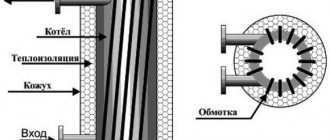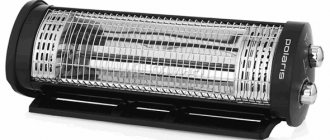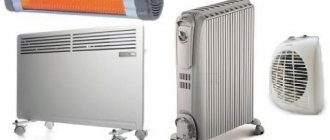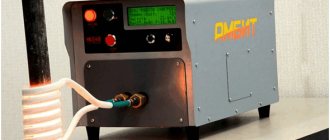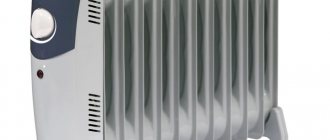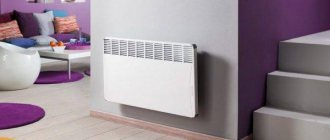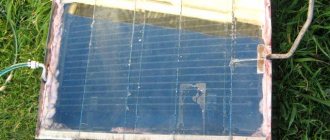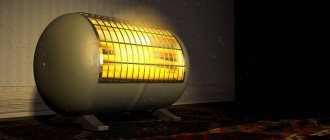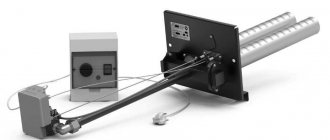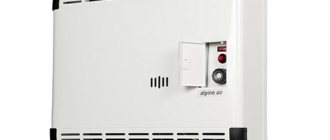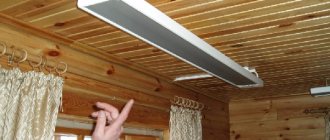What is an inverter
An inverter is a device that converts direct electric current into alternating current or increases the voltage and frequency of alternating current. The need for such a transformation arises when creating devices and mechanisms with a sensitive system of settings that respond to the slightest change in environmental parameters. Inverters are used in many areas: electric welding (in fact, a welding machine is a type of inverter), control of electric motors and electric drives, production of air conditioners and heaters, etc.
As an integral part of the device, inverters look different and may not have an individual housing.
The use of inverters in heating
In the production of heating devices, inverters are used as a device that allows precise pre-setting or adjustment during operation of the unit.
High-tech electric heating devices that do not have heating elements, lamps, filaments and heating coils in their design necessarily include inverters as devices for increasing the functionality and efficiency of the heating unit. Such heating means include vortex induction heaters (VIN) and inverter air conditioners. Both of these devices are descended from their less advanced predecessors: VIN - from induction boilers of the SAV type, inverter split systems - from conventional air conditioning systems.
How it works: device and principle of operation
In heaters, the operation of the inverter is tied to controlling the ambient temperature and optimizing heat flow. The principle of operation can be clearly seen by comparing the operation of a simple heater (A) and an inverter heater (B).
- Simple heater:
- when connected to the network, the device heats the air to the value set by the user;
when the temperature exceeds the temperature sensor, the device turns off;
- After some time, the air in the room cools down and the unit turns on at full power.
- Inverter heaterThe inverter is built into the control unit, where it converts alternating current into direct current and back into alternating current, but at the required frequency.
- When turned on, the heater brings the air to the user-set value;
- when the desired temperature level is reached, the operating power is automatically reduced - to 5-10 percent of normal power;
- In this way, the temperature will drop at a slower pace and heating will start when the set value is passed.
The consequences of cyclic on-off switching are a jump in power consumption in the network, maximum load on the device during startup and wear of parts.
The figure shows a comparison of the operation of a conventional air conditioner and an inverter.
Operating principle
Models powered by electricity transmit energy using heating elements, which require both a separate area for heating the coolant and protection of the heating element from corrosion. At the same time, the operating principle of inverter boilers is based on the phenomenon of electromagnetic induction.
Direct current from the network is converted into alternating current. The resulting magnetic field generates an induced current. And the device that allows all this to happen is precisely an inverter, capable of operating both from the network and from a battery (only for low-power models).
Boiler design
An inverter boiler consists of two main parts: a magnetic circuit and a heat exchanger. The circuit's tasks include creating an alternating magnetic field.
A heat exchanger is needed to transfer energy from the induction current to the coolant, increasing the temperature of the latter to the level necessary for effective heating.
Main characteristics
The service life of inverter heaters is longer due to the absence of peak loads
The installation converts the incoming alternating current into direct current, and then again converts the direct current into alternating current, but with different characteristics. As a result, the device does not work with mains electricity, but with current with improved performance. This prevents damage to the device during power surges: the heater lasts longer and operates with greater efficiency.
The work scheme is also changing. A conventional heater, when turned on, heats the air to a specified temperature, and when reached, turns off completely. When the sensor signals a decrease in the temperature in the room, the device turns on again. However, starting the device causes a short-term peak load. This mode contributes to rapid wear of parts.
An inverter heater for a home works differently. When turned on, the heater heats the air to the specified temperature, but after reaching it it does not turn off, but reduces the operating power to 5–10%. When the temperature drops below the marked value, the heater increases power.
In this mode, the power gradually increases and decreases, and there are no peak loads. The temperature also changes more smoothly, which allows you to increase shutdown time and reduce electricity consumption.
Inverter heater, convector with inverter control unit, principle of operation.
The inverter heater (also known as a convector with an inverter control unit) first appeared on the market in 2017 under the Electrolux and Ballu brands. The main feature of these heaters is their record low energy consumption - 80% lower than conventional heaters with a mechanical thermostat.
Operating principle of an inverter heater
An inverter convector can most clearly be compared with the climate control system in a car: as soon as we get behind the wheel, the heater turns on at full capacity, using all its resources to heat the car interior as quickly as possible. After it achieves its goal, it does not turn off, but goes into minimum power mode or into temperature monitoring mode. An inverter convector works in exactly the same way: at first it works using all its power, and when approaching the desired temperature, it gradually reduces it, switching to partial load mode.
What it looks like in practice: There is a convector with an inverter control unit and a power of 1.5 kW. There is a room of 20 m2. We need to warm it up to +25 degrees. We turn it on, the heater works at maximum, and the closer the desired temperature gets, it reduces the power of the heating element (therefore, energy consumption decreases) so that the room is not overheated, and when the desired point is reached, it works in minimum mode or simply monitors the temperature. The minimum mode is approximately 300 watts. What is 300 watts? The power of the old Soviet boiler is 300 watts. This power is sufficient when the heater simply has to operate in support mode.
At the same time, if we open a door/window and it becomes noticeably colder in our room, the inverter convector notices the difference in temperature changes and immediately begins to heat at higher power in order to return the temperature set by the person. There are no efficiency tricks here, everything happens by measuring the temperature dynamically (every 10 seconds the control unit measures the temperature and understands what it needs to do - increase/decrease/do nothing) and smart control of the heating element.
Graphic representation of the operation of an inverter heater
Below is a schematic representation of the operating principle of an inverter convector. As you can see, it never turns off, is always in a partial load state, ensuring always even temperatures and minimal power consumption. Inverter convector - green line, conventional - orange line.
Review of inverter convector Electrolux Air Gate 2
Hello everyone, today we will tell you about the Electrolux Air Gate 2 inverter convector.
Unit No. 1: Electrolux Air Gate 2 Transformer with inverter control.
Everyone asks - why is this a transformer? Let's tell you - it is sold in parts in different boxes (heating module + chassis + control unit + wi-fi), you assemble it yourself, that's why it is called a transformer. We will tell you in more detail in one of the last paragraphs.
The model appeared in the fall of 2021, the line consists of three devices of varying power:
- 1.5 kW model – for rooms up to 20 m2
- 2.0 kW model – for rooms up to 30 m2
- 2.5 kW model – for premises up to 40 m2
About the heating element:
The inverter convector has a new type of monolithic heating element installed: it is smaller in size, and the heat transfer is higher, since additional fins were made (previously it was smooth, like an enamel spoon) over its entire area, and due to this it was possible to make the heater body itself smaller by ¼, while maintaining the same power. So, we managed to make the convector smaller in size, and it heats even better. The speed at which the heating element reaches operating temperature is only 75 seconds, which means that it takes a little more than a minute to start heating normally. Units of heaters can do this, this is a very high indicator.
Convector housing:
The convector body is made of metal, and the plastic elements are made of non-flammable plastic, which cannot become a source of fire or flare up. Air distribution louvers are also made of metal. The maximum temperature of the heating element is 130 degrees, which complies with GOST and fire safety standards. If you think this is a lot, then we’ll tell you: stitch heating elements in heaters heat up to 600 degrees, steel heating elements in an aluminum jacket - 300-400 degrees.
Placement of the convector: hang on the wall or place on a wheeled chassis:
The convector can be installed either on a wheeled chassis or hung on the wall using brackets, they are included in the kit. When installing on a wall, please note that the power cord is only 1 meter long and it comes from the top of the convector (from the inverter control unit), so most likely you will need to install a separate outlet (to make it as aesthetically pleasing as possible and not have wires stretching throughout the house) . Wire 220 is located on the left side at the top of the convector, so it is better to connect the socket on the same side. Here is an example of a wall-mounted convector from our client.
And here is a general view of the inverter convector on the wall (published with the kind permission of our client):
The installation process itself is easy and does not take more than 10 minutes - the kit includes all the necessary fasteners and an installation sheet, which you simply attach to the wall (all the markings are on it) and do everything according to the instructions.
Filtration system in Air Gate 2:
The green thing in your hands is a dust filter. And this is the only normal size filter. Other filters - see below.
Another distinctive feature of the Electrolux air gate 2 inverter convector is the presence of a filtration system. I’ll tell you straight - I think this system is unnecessary, since any filter installed on the air intake reduces the flow of incoming air and reduces the efficiency of the device. There are 4 filters:
- Anti-dust (in hands in the photo)
- Catechin
- Carbonic
- Biologically active with vitamin C
I hasten to disappoint with all the filters except the anti-dust one, they look like this. Yes, just some small lozenges. When I picked them up for the first time, I thought that these were samples and that normal filters could be purchased in addition. No, I was wrong))) And such “probe filters” made me very funny)) What is the point of them? Absolutely none. So if you are choosing between Electrolux Rapid Transformer and Air Gate 2 and the presence of filters in AG2 somehow motivates you to buy - think again, these filters are useless, choose what you like best in appearance.
Block No. 2: about inverter technology and its implementation in this convector.
Inverter technology for controlling a convector is a know-how that, at the time of writing this material (February 8, 2019), only Electrolux and Ballu have. The inverter control unit provides stepwise adjustment of the power of the heating element in 20% increments.
- 1.5 kW – 400 650 990 1250 1500
- 2.0 kW – 400 800 1200 1600 2000
- 2.5 kW – 500 1000 1500 2000 2500
Why does a 1.5 kW convector start at 400 (more than 20%) - this is the minimum power, below which there is no point in falling. The remaining segment of maximum power is distributed exactly into 5 parts. We explain: the inverter convector has 5 power levels, which it selects depending on the situation, analyzing the temperature in the room. It adapts to its changes, spending only the amount of electricity that is needed to maintain this temperature, without taking more than necessary, due to this, energy savings occur. The process is completely automatic and does not require human supervision. There is one caveat: the reference voltage at which power measurements take place is 230V. If your voltage is 220 ±10-15%, then the maximum power of the convector may be slightly lower and each step too.
Important: if there are frequent power surges, you will need to install a stabilizer. The permissible voltage differences at which the electronics operate without problems are ±10-15% of 220 volts. If the differences are large, then it is better not to use an inverter control unit - there may be failures. In this case, the most optimal solution is a mechanical control unit with a conventional bimetallic thermostat. It is not afraid of voltage surges, and even if the power goes out, it will turn on again and resume work.
Continuous operation or constant on/off? What's better?
One of the features of the inverter convector is that it almost never turns off. If you take ordinary heaters, they work in on/off mode, that is, turned on/off. This is how almost all refrigerators work: you have 100% noticed that when you go to bed, there is perfect silence at home and suddenly the refrigerator starts working, which means that the temperature in it has risen and the compressor has turned on. And such iterations happen all the time. The inverter convector never turns off: it operates in partial load mode, which allows it to maintain the temperature as evenly as possible and not consume more electricity than required. Below we have provided graphs that illustrate the operating principle of the inverter convector and the on/off system.
Electricity consumption by conventional convectors (which is on/off) and inverter convectors (inverter technology in action)
Schematic representation of the operation of an inverter convector (does not turn off, works constantly, as a result - consumes less electricity)
This is what the convector control unit looks like when it is turned on. Pay attention to the 5 bars: each bar is a step of 20% power. As the set temperature is reached, the number of columns will begin to decrease and you will see and understand at what power the convector is currently operating and how much it consumes.
Block No. 3: about energy efficiency and why an inverter convector saves.
Inverter technology itself is not new - it has been used in air conditioners for a long time and even began to be used in refrigerators not so long ago. Below we give in simple language two examples that are equivalent to inverter technology
Example No. 1: Two drivers in identical cars: absolutely equal conditions. Both need to travel from Yekaterinburg to Chelyabinsk. One drives very aggressively - accelerates sharply, brakes sharply, in a word, does everything that causes high fuel consumption. The second driver is the complete opposite: smooth acceleration and smooth deceleration, which ensure minimal fuel consumption. In our context, the fuel is electricity. The situation is absolutely real. There is no need to arrive first. We're talking about efficiency here. And the second driver is more efficient (inverter convector).
Example No. 2: Climate control system in a car: the heater in the car never turns off, it always works, just with different power. If the car is already warm and good, it works to maintain these conditions. It doesn’t take too much, it doesn’t overheat the car interior, it keeps it at a normal temperature that makes you comfortable! If you are driving at minus 25 degrees and open the door wide open, the car will quickly become cold, and the stove will begin to fight this, increasing the intensity of its work.
Savings are achieved due to the high variability of the use of the heating element, its continuous operation, and partial load mode. It will save a significant amount of money on electricity precisely due to accurate temperature maintenance over a long period, the so-called seasonal energy efficiency.
Block No. 4: safety and can this convector be left unattended?
In short, the convector is fireproof and can be left unattended with a clear conscience, nothing will happen. The convector was sent to the Ministry of Emergency Situations for testing and they showed that it cannot become a source of fire, that it meets all standards and requirements and even more. The body is metal, with a safe coating (not just some kind of paint), which prevents fire. The plastic parts are made of non-flammable plastic, which if something happens can only become a puddle, but not catch fire.
The level of dust and moisture protection is ip24: you can even put it in the dressing room with peace of mind, it can easily tolerate high humidity and is not afraid of water splashes from any angle.
There are two safety sensors inside - against overheating of the case and against tipping over. The overheating sensor will work if the case starts to get very hot and turns off the device. The anti-tip sensor monitors the position of the convector - if the position of the housing changes by 30 degrees or more, it turns off and the circuit opens. We didn’t try to forcefully drop it ourselves, but the manufacturer talked about this sensor.
As for the operating temperature, you can take it into a very cold room (down to -25 degrees) and turn it on there, nothing bad will happen to it, the heating element is not afraid of it.
Block No. 5: remote control of the convector via Wi-Fi.
One of the most relevant functions for summer residents and gardeners: while in the city, you can turn on your inverter convector in advance and it will heat the room before your arrival. The function is implemented by connecting the convector to the home Wi-Fi network and continuously staying in it. How it looks in practice: we arrived at the dacha, connected the convector to wi-fi, left wi-fi working, and returned to the city. We took the mobile phone in our hands, opened the application, and turned on the convector remotely. The application screen will show the current temperature at the location where the convector is installed, so you will be in full control of the situation and understand what temperature needs to be set to make the house warm.
For those who are worried and believe that since there is no stable wi-fi at the dacha, we urge you not to get upset ahead of time. Now it’s 2021 (at the time of writing - February 8, 2021) and you can buy a router with a SIM card inside from any mobile operator, choose the cheapest tariff and take it to your dacha. Wi-Fi control is primarily about comfort.
Other functions that Wi-Fi control of a convector gives you - you can set a timer to turn on/off, you can block the ability to control the convector from its control unit (if there are children, this will be protection from them), you can turn off the backlight of the control unit (Electrolux has it nice blue color).
You can put an inverter convector in each room and name them accordingly, so that from your mobile phone you can understand which convector you are controlling. One convector requires 1 Wi-Fi module.
Block No. 6: the correct configuration of the convector and how not to buy the wrong thing.
The need to talk about this is dictated by two things:
- the stupidity of sellers who themselves do not know anything about inverter convectors and cannot distinguish an electronic control unit from an inverter one, thinking that they are generally two identical, just one with wi-fi and the other without.
- lack of understanding among buyers why everything is sold in parts.
So we come to why a convector is a transformer. It is sold in different boxes. The minimum working configuration is a heating module + inverter control unit. It is from the control unit that the 220 volt wire comes; the heating module itself has only a male-female input connection for this control unit, otherwise there is no way to power it to the network.
Equipment:
- Box with heating module - it contains the heating module itself, two brackets, a set of fasteners for wall installation and a sheet with markings.
- A box with an inverter control unit - it contains the control unit itself, and there may also be a bag with a self-tapping screw for fixing it on the heating module. Sometimes it lies, sometimes it doesn’t. If it's not there, don't be alarmed, it's normal. You can get the required screw from the bag with the heating module.
- A box with a wheeled chassis - there are 4 wheels, two butterfly bolts, two legs to create a wheelbase.
- Box with wi-fi – a plastic box with a wi-fi module. That's it, it doesn't contain anything else.
If you install the convector on the wall, then just the heating module + inverter control unit will be enough, you will not need any other elements. Wheeled chassis and wi-fi are already optional. If you want to install a convector on wheels and make it mobile, then you need a heating module + control unit + wheeled chassis. Wi-Fi is optional. From us you can buy an inverter convector in any configuration, we have them both assembled and in parts.
And this is what the packaging for the Wi-Fi module looks like:
Important: do not let stupid sellers mislead you, they may sell you an electronic one instead of an inverter control unit. Look at the photo below, there is an inverter control unit, it is large and there is a socket for wi-fi. The electronic one is much smaller and without wi-fi.
Another important point: you need exactly an Electrolux air gate 2 transformer - not just an air gate, not an air gate mechanic, not an air gate eco - exactly an Electrolux air gate 2 transformer (marking - Electrolux ech/ag2-1500 t, where 1500 is the required power ), and it requires an inverter control unit. Then you will receive the necessary package. The complete set is shown in the picture below. Sellers may be stupid and not understand (not know, deliberately not talk) about the difference between the air gate and air gate 2 models, so, after reading this text, do not let them mislead you.
Let's summarize:
Think, decide, choose. Remember that when buying an Electrolux inverter convector (also Ballu, they are absolutely identical internally, Ballu just costs less), you are not just purchasing a heater, you are purchasing the opportunity to save on electricity. The maximum allowable savings that have been recorded and confirmed is 83.6%, this means that it consumed 83.6% less electricity and did not allow you to give money to the local power grid company. An inverter convector is about saving. Currently, this technology is used only in devices from Electrolux and Balu; it is new within the framework of convective heating. Here the difference in money is recouped quite quickly, it can save about 1-1.5 tr per month, so the investment in this convector is recouped quite quickly and then simply saves. Yes, you can buy any other convector, which will be cheaper, you will save money, but then it will drag and pull money out of you to pay your electricity bills.
You can buy an Electrolux Air Gate 2 Transformer inverter convector with an inverter control unit in our online store, we can ship it both throughout Russia and to some CIS cities. Within the city of Yekaterinburg - delivery on the same day, because our warehouse is located here.
Electrolux Air Gate 2 Digital Inverter ECH/AG2 1500
8 900
Electrolux Air Gate 2 Digital Inverter ECH/AG2 2000
9 800
Electrolux Air Gate 2 Digital Inverter ECH/AG2 2500
11 000
Types of inverter heater
The devices can operate on liquefied gas and are suitable for country houses
The inverter is capable of changing the characteristics of the heater if the latter is electronically controlled. The actual design of the heater does not matter. But since the technology is expensive, the unit is installed on high-end models.
By type of fastening
These units can be floor-mounted, wall-mounted or baseboard-mounted.
- Floor-standing ones are distinguished by the presence of wheels, which allows you to transport the unit from one room to another. This suggests that floor-standing options are mobile. For example, when heating one room, you can then warm up another. And given the low power consumption, this device has even more advantages.
- Wall-mounted devices are mounted on vertical surfaces. Less mobile than floor or baseboard ones.
- Due to their special structure, baseboard They have the principle of operation of a water baseboard, when the entire area is heated at once. Another advantage is that the presence of any cold places is suppressed by the heat created, various changes in the room temperature are prevented, and rooms do not fog up. This type of equipment can also be easily moved and transported, just like floor-mounted equipment.
By type of heating element
Presented in 3 types:
- electric;
- gas;
- energy saving.
Electric ones operate from the mains. Such devices are popular among those who purchase them for an apartment.
Gas models operate using gas. The main function is to maintain heat in small areas or even in some unheated rooms. The advantage is that with low fuel costs, the device effectively heats the entire room.
Ergonomics, simplicity and high mobility make them an ideal option for their price.
Energy saving is suitable for those people who do not have a particularly powerful electrical system. Considering the increased efficiency (compared to other equipment of this type), this feature makes this type of equipment even more preferable. If you look at statistical calculations, you can see that the total amount of electricity saved is up to 60%. Very serious numbers, especially with high efficiency.
Also, the elements themselves can be of different types.
- A heating element in the form of a tape or needle. The loops are located on the sides of the plate, and these loops are frangible. Due to the fact that the design does not include fins, the air heats up rather slowly. Nowadays it is rare to find such equipment, since it has not been produced for a long time.
- A heating element (tubular electric heater) can also heat. The tube consists of ribs. The greater their number, the more heat the room will receive. The heating element can heat up to a high temperature, so the efficiency of this device is higher than that of a tape or needle.
- The monolithic type has a special design. The nichrome thread is housed in a ribbed housing made of aluminum. Thanks to this, the likelihood of losing heat is extremely low. Low noise level.
Gas
Such heaters operate on natural or liquefied gas. Since it is a cheap fuel, heating a room costs only slightly more than using hydronic heating. It is designed for heating large areas and is perfect for a summer residence.
Inverter technology increases the efficiency of the device. The burning intensity of the burner changes smoothly, which eliminates the risk of extinguishing the flame. Fuel is consumed even more economically. Inverter units are more compact than conventional gas heaters.
Infrared
The principle of IR heaters is to heat objects in the room, which then radiate heat
The heating elements emit infrared radiation - this is a plus. In this case, it is not the air in the room that heats up, but surfaces, objects and people. This makes it possible to provide comfort at an actually lower temperature.
The heater works the same way as the others: it turns on when the temperature drops and turns off when it rises. An inverter electric infrared heater works without switching off, only reducing the heating intensity. The device consumes much less electricity with high heat transfer. This is important because electricity is expensive.
With heat pumps
This refers to air conditioners that can operate in reverse mode - not only for cooling, but also for heating. The fan blows cold air from the outside, but since the temperature of the refrigerant is still much lower, the latter boils and condenses at the compression stage, releasing heat. The heat is transferred to the air in the room through the heat exchanger. Thus, an air conditioner with a heat pump receives heat from air with a temperature of up to 0 C.
Such a system turns out to be cheaper than an electric heater. An inverter unit makes the air conditioner even more economical. When the desired temperature is reached, it does not completely turn off the installation, but switches it to minimum power mode. Without peak loads, the device operates longer and consumes less electricity.
Convectors
The inverter operating circuit has been introduced into convection-type heaters
The inverter is also installed in electric convectors. Such models are presented by Electrolux and Bally. The principle is the same: the unit does not turn off the device, but reduces the power. The heater operates in maintenance mode most of the time. At the same time, it consumes less electricity and wears out less.
In this mode, heating elements heat up to a lesser extent and less oxygen is burned. Inverter convectors are safer for health.
Pros and cons of the device
Advantages of an inverter heater:
- When the desired temperature is reached, the unit does not turn off, but switches to operation at low speeds.
- It doesn't waste a lot of energy because you don't have to constantly turn the device on and off. Energy savings compared to other heating devices are 30-50%.
- Maintains the set air temperature by smoothly controlling the speed of the compressor motor.
- The device has high performance. It is capable of heating even at very low temperatures.
- Safe and environmentally friendly.
- It operates almost silently, thanks to the built-in fan.
Advantages of inverter devices
The disadvantages include:
- High cost compared to other heating devices.
- Sensitivity to voltage changes.
- Spare parts are not standardized, so repairs may take several weeks.
Choosing an inverter
When choosing an electric heater for your home, make sure the unit is safe.
Pay attention to the wires. The main criteria are quality and resistance to voltage surges. It is mandatory that the device bears the CE mark. Its presence confirms that the heater was manufactured in accordance with European standards. For a small room, a compact inverter heater is suitable. The power of the device is calculated by the formula: 100 W of power is required per 1 square meter.
Choose a convector with an electronic control system. This will allow you to set the exact temperature and control the device from a distance (depending on the model).
Why is it economical
Inverter heaters are considered one of the most cost-effective devices. How does this manifest itself? Let's start with the fact that such systems, having reached the required temperature level, do not completely turn off. The device continues to operate, reducing the speed to a minimum. This process leads to maintaining a comfortable and favorable climate in the room. At the same time, the heater does not waste extra electricity turning it on and off.
In addition, inverter heaters do not use “high current” for starting during their use. This is also beneficial for consumers. When starting the unit, the current does not exceed the rated current. And this has a positive effect on the service life of such devices. In this case, the device is not constantly in the on and off mode. Such cycles significantly reduce the life of the equipment. It is worth noting that, unlike conventional heating devices, inverter heaters can save up to 40% of electricity.
Performance and practicality
Now you know what inverter heaters are. Such heating devices differ from others not only in efficiency, but also in productivity. It is worth noting that an inverter heater is capable of heating a room even at the minimum temperature. At the same time, the efficiency remains quite high. During operation, the equipment shows the ratio of energy expended and the amount of heat generated. This proportion is designated EER. This indicator for inverter heaters is almost equal to 4.
In other words, with a unit consumption of 250 kW, 1 kW of heat is obtained. This indicator is quite good for household appliances.
Heating system installation
Before you begin installing an inverter heating system in a building, you need to determine what equipment will be needed for this. The power of the product is selected depending on the area of the heated premises, taking into account heat loss and a small reserve.
It is approximately believed that 1 kW of heating equipment performance is sufficient to ensure normal microclimatic conditions in an area of 8–10 square meters. m.
For rooms with non-standard heights, for example, production workshops, a kilowatt is enough to heat 2 cubic meters of air.
Features depending on the type of equipment
Based on the calculated power of the boiler, the type of electrical network required to connect it is selected, which can be single- or three-phase. The first is suitable for equipment with a power of up to 10–12 kW, most often used for heating dachas or small private houses. Three-phase is designed for inverter devices with a capacity above 6 kW.
At the same time, boilers with a power of 6 to 12 kW can be connected to a network with a voltage of both 220 and 380 Volts. Such equipment can be used without creating an additional circuit.
In addition, when choosing an inverter boiler for large industrial premises, they prefer industrial equipment with increased dimensions, large heat exchangers and a complex current conversion system. While for home use you will need a household model, relatively compact and cheap.
Operating rules
In order for the device to serve for a long time, it is necessary to adhere to certain rules during operation:
- The distance from the heater to any object must be at least 500 mm.
- The unit cannot be placed under a window opening.
- Experts do not recommend leaving the device turned on overnight; this can only be done if there is a thermostat inside it that regulates the frequency of operation.
- You should not dry things on a heater.
Energy efficiency is now considered one of the most important criteria when choosing heating devices, so you should carefully approach the purchase of heaters. Unlike convective heating (central heating, oil radiators), inverter devices allow you to warm up that part of the air mass where people are, which is very convenient and profitable.
How to use the device correctly
Unlike an oil heater or central heating, inverter heaters automatically reduce their power when the room has reached a set temperature, which will save money for customers. To achieve the maximum shelf life of the device, there are several rules that will extend its service:
- the distance from the device to the nearest object or surface should not be less than 40 centimeters;
- It is not recommended to leave it on overnight;
- do not place wet clothes on it;
- Do not install the device near a window.
See also -
How to choose the ideal air conditioner for your home and apartment
Manufacturers and popular models: ranking of the best and prices
The most widespread use of inverter heaters in everyday life is in convector heaters and split systems - a new generation of air conditioners with an improved freon conversion mechanism.
Split systems
Among the manufacturers with a developed dealer network on the Russian market are Mitsubishi, Toshiba, Samsung, Aeronik. The most popular are models in the middle price segment, designed to heat a room of 20-30 m2. These are models with low noise levels - within 15-30 dB.
Ballu BEC/EVU-2500
pros
- Convenient control via smart Wi-Fi module
- Easy to install even by yourself
- There is overheat protection
- Interesting design
Minuses
- Short power cord
From 4,000 ₽
The review begins with the best heater, capable of heating the space around it in the shortest possible time. In this case, the module itself does not overheat, but remains at operating temperature. It works almost silently and is absolutely safe. If you are installing it on a wall, then the included mounting brackets are quite suitable. Otherwise, you may need to purchase additional fasteners.
Electrolux ECH/R-1500 T
pros
- Warms the air evenly
- Low cost
- Possibility of connecting a control unit
- Great design
- Convenient wall mounting
Minuses
- Gets dirty easily
From 3,000 ₽
If you need to choose an inverter heater for your home, it is recommended to pay attention to this model. Compact device with good characteristics. Guarantees excellent air heating at some distance from the source. At the same time, energy consumption is much more economical. Manufacturers have slightly modified the shape of the body so that the blinds redirect air flows with the greatest efficiency. The device reaches the desired temperature quickly enough.
Split system Aeronik ASO/ASI-12HM
Development of the Australian company Aeronik PTY LTD. The ASO/ASI-12HM model is positioned as the best solution for allergy sufferers; it is equipped with additional air purification and ionization filters. Another feature of this model is the interchangeable mirror panels of different colors, which allows you to conveniently fit it into the interior.
Characteristics:
- Power in cooling mode: 3200 W
- Power in heating mode: 3400 W
- Heating power consumption: 987 W
- Heating area: 33 m2
- Dimensions of the inner side (WxHxD): 80x29x18.6 cm
- Dimensions of the outdoor unit (WxHxD): 74.5×55.2×32.8
- Price: 23,600 rub.
Toshiba RAS-07EKV-EE/07EAV-EE
Split systems of the EKV series are manufactured at the Toshiba plant in Thailand. The model is positioned as a low-power solution for servicing city apartments with small rooms.
Characteristics:
- Power in cooling mode: 2000 W
- Power in heating mode: 2500 W
- Heating power consumption: 590 W
- Heating area: 20 m2
- Inner side dimensions (WxHxD): 79×27.5×20.5
- Dimensions of the outdoor unit (WxHxD): 66x53x24
- Price: 25,100 rub.
Climate control unit Mitsubishi Heavy Industries SRK-25ZM-S
In terms of consumer properties, this is a premium model. It implements the most comfortable options for the distribution of heat flows. Air purity is ensured by multi-stage filtration, and constant ionization is also carried out even when the system is turned off due to the tourmaline coating of the block elements.
Characteristics:
- Power in cooling mode: 2500 W
- Power in heating mode: 3200 W
- Heating power consumption: 800 W
- Heating area: 25 m2
- Inner side dimensions (WxHxD): 79.8×29.4×22.9
- Dimensions of the outdoor unit (WxHxD): 78x54x29
- Price: 39060 rub.
Samsung AR09HSSFRWK/ER
Modern split system from a South Korean manufacturer. The model belongs to the Luxury line. The AR09HSSFRWK/ER uses its own Visual Doctor technology to purify the air. Can operate in fan mode.
Characteristics:
- Power in cooling mode: 2500 W
- Power in heating mode: 3200 W
- Heating power consumption: 620 W
- Heating area: 26 m2
- Inner side dimensions (WxHxD): 93.6 x 27 x 26.4
- Outdoor unit dimensions (WxHxD): 79 x 54.5 x 28.5
- Price: 35,000 rub.
Convector heaters
According to consumers and experts, the most popular are convector heater models with a built-in inverter from Timberg and Huyndai.
Timberk TEC.E0 M 2000
Timberk convectors are manufactured in Finland. The TEC.E0 M 2000 offers floor and wall mounting options, rollover protection and UltraSilence technology.
Characteristics:
- Heating power: 2000 W
- Overall dimensions (WxHxD): 80x45x8 cm
- Weight: 4.6 kg
- Price: 2600 rub.
Timberk TEC.E0 M 2000 – environmental friendliness and safety
The main task of the TEC.E0 M 2000 convector is to heat rooms up to 15-20 square meters. m. Such equipment is worth buying both for use in an apartment, and for a summer house or office. Operational safety is ensured by the presence of a protective sensor.
In addition, the design of the device allows for both wall mounting and floor installation. The kit includes parts for two options - brackets and support legs. You can select the optimal mode using a convenient regulator. The first stage provides a power of 1.2 kW, the second – 2 kW.
Features of the technology include the Heating Energy Balance technology used. It increases the environmental friendliness of using the device and provides instant heating. Acceptable microclimatic conditions will be obtained in just 30-60 minutes after turning on the device.
Other reasons for purchasing include the device’s resistance to voltage surges, light weight, and lack of noise during operation or shutdown. The latter feature allows the device to be used for heating living rooms, including a bedroom or children's room.
Advantages of the technique:
- quiet operation;
- installation on the floor and mounting on the walls;
- lightness – the device weighs only 5 kg;
- compactness – the heater does not take up much space;
- availability of power adjustment;
- reliability of fall protection;
- heating rate.
Disadvantages of the device:
- drying the air during work;
- the length of the cord, due to which the equipment will have to be placed close to the outlet;
- lack of wheels on the legs to move the device.
